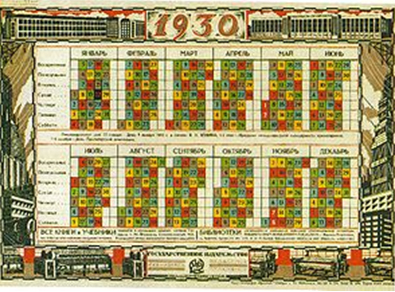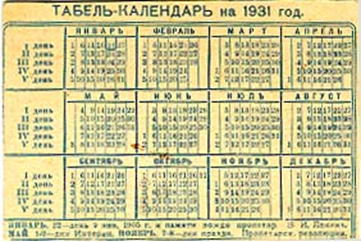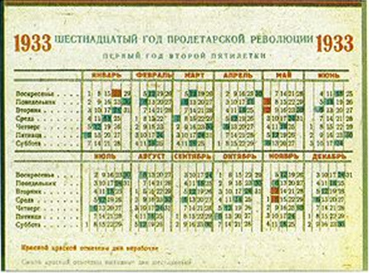20th Century Soviet Calendar Reform
Soviet reform of the Gregorian calendar was very different from the French reform during the Revolution. While it did not set aside the Gregorian calendar year, the new reform completely restructured the weeks. The official reason was for greater productivity from workers and factories, but like the French reform before it, the Soviet calendar reform was in large part a reaction against religion.
In May of 1929, Yurii M. Larin proposed a continuous production week.1 While at first his proposal was lightly dismissed, by the very next month he had won the support of Joseph Stalin, premier of the Soviet Union. Any opposition to the proposed reform was quickly crushed as "Counterrevolutionary bureaucratic sabotage." 2Two months later on August 26, 1929, the Council of People's Commissars (CPC) decreed that all productive enterprises were to transition from the traditional work week interrupted by a weekend, to a continuous production week.  Further, the CPC stated that it was "essential that the systematically prepared transition of undertakings and institutions to continuous production should begin during the economic year 1929-1930."3The idea appeared simple: divide all workers into shifts. This applied not only to factory workers, but to retail and government workers as well. With factories and stores open and producing 24 hours a day, every day of the week, productivity would increase. This was called the nepreryvka or "uninterrupted" week.
Further, the CPC stated that it was "essential that the systematically prepared transition of undertakings and institutions to continuous production should begin during the economic year 1929-1930."3The idea appeared simple: divide all workers into shifts. This applied not only to factory workers, but to retail and government workers as well. With factories and stores open and producing 24 hours a day, every day of the week, productivity would increase. This was called the nepreryvka or "uninterrupted" week.
The reform was simple in appearance only. The effect on social life was disastrous. Weeks were five days long. Each day was coded with either a Roman numeral, I to V, or a color. These colors soon came to be identified with certain days of the week. Workers were assigned a number or color to indicate their days off.
With such a large segment of the country's population at work on any given day, the result was that it isolated friends, church members and families from each other. If the husband rested every Red day, the wife rested every Blue day and the children were out of school every Green day, there were very few opportunities for socializing together even within the family unit, except after a long day of work.
It was quite understandable that one would become associated with one's regular weekly day off work, since the latter would be shared by only one fifth of the rest of the Soviet society. Soviet workers may have rested more often than their  Western counterparts (once every five, rather than seven, days), yet they certainly did not rest together, as one society, since 80 percent of the entire Soviet working population would be at work on any given day.4
Western counterparts (once every five, rather than seven, days), yet they certainly did not rest together, as one society, since 80 percent of the entire Soviet working population would be at work on any given day.4
Whether Muslim or Jew, Christian or Atheist, a person's life revolves around his days off work. The Soviet calendar experiment was vastly more radical than that of the French. Instead of just changing the number of days in a week, the Soviets basically had society broken up into fifths: one-fifth of society living by one calendar; the second one-fifth living by another, the third by still another, and so on. This fragmented society. Churches, families, society as a whole was no longer a harmonious unit, but was, in a very real sense, five separate societies that lived parallel, rather than intersecting, lives.
As a social experiment, it led to a complete breakdown of the family unit.
That one would tend to choose one's friends from among those who shared the same days off is quite understandable, particularly given that, on days when workers had a day off, only about 20 percent of the people they knew would be available for socializing, the other 80 percent being at work. The problems inherent to trying to get together with people whose work schedules are essentially out of phase with one's own are obvious.
However, as indicated by the following complaint, which appeared in the official newspaper Pravda on the very day the nepreryvka [uninterrupted week] was put into effect, such problems were dwarfed by the actual disruption of family life brought about by the reform: "What is there for us to do at home if our wives are in the factory, our children at school, and nobody can visit us. . . ? It is no holiday if you have to have it alone."5
In order for healthy relationships both in and outside the family circle, it is important to have opportunities to spend time together. "Given the traditional Marxist aversion toward the family, it is quite conceivable that the eventual destruction of the family may have even been on the actual agenda of the architects of the Soviet calendrical reform."6
The discontent of the populace soon led to a modification of the calendar reform. On March 16, 1930, the "Government Commission of the Council of Labor and Defense on the Transition of Enterprises and Offices to a Continuous Production Week" acknowledged the need for families to have similar days off and that such requests should be taken into account when assigning work schedules.7The CPC issued a decree on November 23, 1931,8which ended an experiment so destructive to Soviet family/social life.However, this did not restore the traditional seven-day week. From then until June of 1940, the Soviet Gregorian calendar was divided up into months containing five weeks of six days each, or the chestidnevki. The sixth day was the common day off for everyone.
to have similar days off and that such requests should be taken into account when assigning work schedules.7The CPC issued a decree on November 23, 1931,8which ended an experiment so destructive to Soviet family/social life.However, this did not restore the traditional seven-day week. From then until June of 1940, the Soviet Gregorian calendar was divided up into months containing five weeks of six days each, or the chestidnevki. The sixth day was the common day off for everyone.
While the whole subject may appear as a somewhat dry phase of history founded upon the greed of the Soviet hierarchy for more production from the common worker, the real motivating power behind it all was, once again, religiously motivated. While the modern Gregorian week is founded upon paganism, nevertheless, its length is equivalent to the length of the Biblical week, both having seven days. When the Soviet week was shortened to five days, the two days that were to be left off were Saturday and Sunday, the traditional Judeo-Christian days of worship. "To appreciate the antireligious significance of this move, note that, originally, the days of the week were even supposed to retain their traditional names, with only Saturday and Sunday being removed from the weekly cycle."9In fact, a cartoon from the time published in a newspaper for Russian émigrés, depicts Saturday and Sunday being shot by a Soviet soldier. The crime? "Their bourgeois origins."10
Karl Marx, in his Critique of Hegel's Philosophy of Right, had stated:
Religion is the sigh of the oppressed creature, the heart of a heartless world, just as it is the
 |
| December 12, 1937, Sixth day of the six-day week |
spirit of a spiritless situation. It is the opium of the people. The abolition of religion as the illusory happiness of the people is required for their real happiness. The demand to give up the illusion about its condition is the demand to give up a condition which needs illusions.
Marx' main point was that religion was merely an escape from reality. Demanding that religion be given up, he was saying, was also a demand to change reality so that such escape was not needed. However, a single sentence became the rallying cry of the Soviet regime: "Religion is the opiate of the people." As such, religion was viewed as a superstition for the weak-minded that should be crushed out. "As in France 140 years earlier, the main purpose of abolishing the seven-day week in the Soviet Union was to destroy religion there."11
By changing the weekly cycle, the entire nation was to be removed from the traditional weekly cycle of the three main religions: Judaism, Christianity and Islam. The seven-day weekly cycle was to have no bearing on Soviet daily life. Not only would it be difficult to keep track of one's worship days, but only once in every thirty five days (when the new five-day and the old seven-day weeks coincided) would a worker even be able to attend church, mosque or synagogue. When the Commissar of Labor voiced his concern over the future of Sunday as a viable day in the calendar, he was emphatically told that the purpose for the reform was to, in essence, "combat the religious spirit."12
Worship and marriage are two divine institutions that came under attack under this diabolical calendar reform. The overthrow of this reform began with the devout among the peasants:
As in France 140 years earlier, it was the essentially traditionalistic rural population who spearheaded the movement to preserve the seven-day week. When the authorities insisted that they rest in accordance with the new secular weekly rhythm, many peasants followed the example set by their French predecessors and sabotaged their efforts by taking off both the official rest days and their traditional weekly days of worship, which they defiantly marked on the official calendars issued by the government's printers. 13
The calendar reform did not have the production and monetary benefits first envisioned. Not only did machines break down more as there was no time taken off for routine maintenance, but also with workers in the same factory leaving work or returning to work every single day the lack of continuity in the work force contributed to decreasing production but increasing irresponsibility which, in turn, decreased production still further. The official reason given for abandoning the calendar reform was to restore productivity. However, a large contributing factor, although unstated, was the peasant refusal to fully comply.
To appreciate the role played by religious sentiments in the downfall of the chestidnevki [the six-day week], note that, along with their restoration of the seven-day weekly cycle, the Soviet authorities also reestablished Sunday as the official weekly day of rest. Had it not been for powerful religious pressures which it apparently could not resist, the government could have easily chosen any of the other six days of the restored cycle, particularly given the fact that Sunday – the religious associations of which resonate even in its name, Vockresen'e, which literally means "Resurrection" – had officially been dead for almost eleven years!14
On June 26, 1940, the Presidium of the Supreme Soviet restored the seven-day week. Calendar reform was by no means dead, however. Elsewhere in the world, agitation for a world-wide reform of the Gregorian calendar was growing.
1 The Soviet Union had been on the Gregorian calendar for only 11 years. On January 25, 1918, the Council of People's Commissars (CPC) decreed that the Soviet Union would no longer use the Julian calendar but would switch to the Gregorian calendar. This was done February 14, 1918.
2Eviatar Zerubavel, The Seven Day Circle: The History and Meaning of the Week, The University of Chicago Press, 1985, p. 35.
3Solomon M. Schwarz, "The Continuous Working Week in Soviet Russia," International Labour Review, 1931, Vol. 23, pp. 157-180.
4Zerubavel, op cit., p. 37.
5Zerubavel, op cit., p. 38.
6Ibid. See also Lancelot Lawton, "Labour", p. 602 in P. Malevshy-Malevitch (ed.), Russia U.S.S.R., New York: William Farquhar Payson, 1933; W. E. Moore, Man, Time, and Society, New York: John Wiley & Sons, 1963, p. 122.
7Katherine Atholl, The Conscription of A People, New York: Columbia University Press, 1931, p. 107; Izvestia, March 17, 1930.
8 E. M. Friedman, Russia in Transition, New York: Viking, 1932, p. 262; Albert Parry, "The Soviet Calendar", Journal of Calendar Reform, 1940, Vol. 10, p. 67.
9Zerubavel, op cit., p. 36; P. M. Dubner, "Uninterrupted Week and Labor Productivity," Predpriyatiye 1929, Vol. 73, No. 9, p. 51.
10Atholl, op cit., p. 84
11Zerubavel, op cit., Walter Kolarz, Religion in the Soviet Union, New York, St. Martin's Press, 1961, p. 31; Lawton, op cit., p. 602
12Atholl, op cit.
13 Zerubavel, ibid.
14Zerubavel, op cit., p. 43.









